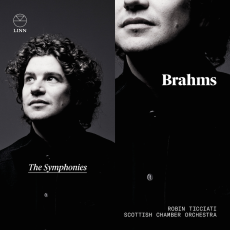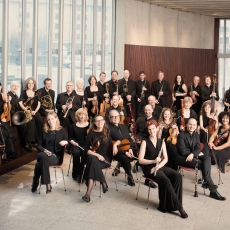Robin Ticciati & SCO - Brahms: The Symphonies - Gramophone
On paper, Robin Ticciati’s new set of Brahms’s symphonies bears a striking resemblance to the Scottish Chamber Orchestra’s previous recording with Sir Charles Mackerras (Telarc, 10/97). Both cycles are closely modelled on the performing tradition of the court orchestra at Meiningen, where Brahms conducted the premiere of his Fourth Symphony. No surprise, then, that the interpretative decisions Robin Ticciati enumerates in his booklet note are nearly identical to those laid out in Mackerras’s, including the deployment of Viennese horns and small-bore trombones, and the same configuration of 34 strings who play with ‘the notion of vibrato as ornament’.
In practice, however, the interpretations sound nothing alike. Mackerras’s recording is reassuringly sonorous, despite the smaller complement of strings; Ticciati’s is lean and quite dazzlingly transparent. Listening with score in hand, I marvelled at the conductor’s meticulous observance of Brahms’s markings. Nearly every instruction regarding dynamics, phrasing and articulation is accounted for. Impressive, too, is the orchestra’s ability to render these details with such a fine balance of precision and expressive brio – evidence of Ticciati’s salutary impact on the orchestra during his nine years as music director.
The woodwinds – inevitably spotlit in such a compact ensemble – are marvellously characterful. Sample any of the slow movements, as their playing is consistently and memorably affectionate in all four. The brightly burnished brass are clearly mindful of the delicacy required in an orchestra of this size. And the strings? On the Telarc set, there were quite a few ragged moments and a sense they were sometimes striving to project a larger sonority than was practicable. Here, however, their precision and unanimity are beyond reproach. Listen at 8'00" in the Allegro of the First Symphony, where they whip up a maelstrom through frothing, spitting articulation. And then how nobly sung and evenly balanced their corporate tone is in the finale’s anthemic tune at 4'14".
Perhaps the most conspicuous difference between Mackerras’s and Ticciati’s Brahms is in the matter of vibrato. Both officially subscribe to Joachim’s dictum that vibrato be applied only where demanded by expressive necessity but it’s Ticciati who goes full tilt. The opening movement of the First Symphony sounds an awful lot like Beethoven played on period instruments. It’s not the Brahms I grew up hearing but it’s thoroughly compelling and often downright thrilling. I’m less convinced in the intermezzo-like third movement, despite the lovely wind-playing, because it strikes me that there are places where ‘expressive necessity’ is overlooked. Take the lovely violin line at 3'16", marked molto dolce, which lies pale and flat in Ticciati’s reading; Andris Nelson has the Boston violins make this little line take my breath away (BSO Classics, 9/17).
I’m more troubled, however, by Ticciati’s tendency to allow his focus on detail to impede the music’s large-scale phraseology – that fabled ‘long line’. In the finale of the Second, for instance, he appears so intent on following the articulation markings that the phrases end up sounding stitched together rather than flowing easily, as they do so joyfully on Paavo Berglund’s account with the Chamber Orchestra of Europe (Ondine, 8/01). Or, to take a more melancholy example: I wish the succession of two-bar phrases in the Poco allegretto of the Third added up to more than the sum of their parts; Chailly, for one, weaves these heaves and sighs into an expansive, unified soliloquy. And I simply cannot fathom why Ticciati breaks up the granitic structure of the opening movement of the Fourth with so many (unwritten) pauses – particularly given that his readings of the outer movements of the Third (so much trickier to pull off) are so cogently argued.
Still, there’s much to admire in these recordings beyond the stellar playing of the SCO and Linn’s state-of-the-art engineering. Ticciati comes to these symphonies with a veritable flood of fresh ideas. Admittedly, not all are equally convincing, but there’s hardly a dull note, either – and that in itself is no small feat in such familiar repertoire.


